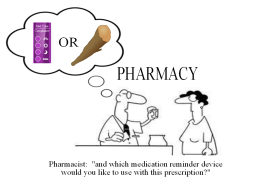For the most part people go to their physician or healthcare provider to get help or treatment for a medical problem. But some people are so stubborn they’ll wait until the last minute, suffering with an ache, pain or other uncontrolled symptom of disease or condition until they have no other recourse but make an appointment to see their doctor. It’s often only when they get to this virtual point of no return are they willing to give in, seek advice and visit their ‘healer’ of choice.
Similarly, due to stubborness, the desire to follow doctor’s orders seems to disappear for many patients as soon as the prescribed treatment or therapy relieves the pain or symptoms they were suffering from. This happens all too often with antibiotic therapy where patients stop taking their medication when symptoms subside, terminating the therapy before the full course of treatment has ended. It’s also evident when a patient is prescribed a maintenance medication to control a disease or chronic condition such as hypertension, cardiovascular disease, COPD or diabetes, often leading to uncontrolled symptoms, progression of disease state or even death.
What can we do to increase patient adherence and compliance with their prescribed medication regimen?
Lack of medication adherence… America’s other drug problem-
Adherence and compliance to medication therapy or prescription drug regimen seems to be an ever looming problem, adding over $300 billion in healthcare expense annually in the U.S. alone. Recent statistics posted by Express Scripts indicate 69% of non-adherence to drug therapy is behavioral in nature resulting from forgetfulness or procrastination. So what’s it going to take to get people to take their medications?
No Wooden Clubs or 2 by 4’s –
Pharmacists are continually frustrated with this problem. I’m sure physicians and other prescribers are as well. Because, for the most part, we can’t “make” a patient take their medication if they don’t want to. Even when we spend the extra time to educate patients about their disease state and prescribed medications we can’t compel anybody to be compliant if they’re unwilling to do so.
Improving medication adherence and ensuring timely medication use are the greatest opportunites to cutting the nearly one-half trillion dollars of avoidable healthcare costs worldwide. Any measures taken to reduce this expense and advance the responsible use of medicines will lead to improved health outcomes as well.
What we can do, and should do, is to continue to educate, offer encouragement and provide medication reminder devices and tools to help patients who need to improve their medication compliance.
There are many tools available ranging from simple pill boxes and reminder caps on pill bottles to smart phone apps and automated pill dispensers. Some of the most unique, innovative and easy to use reminders devices are the medication compliance cards from Med Time Compliance. These devices can be designed for specific needs ranging from their iRemindHer once a day oral contraceptive compliance card and multiple daily dosing reminder cards to unique products designed for complex dosing regimens such as growth hormone injections or chemotherapy medication regimens with variable dosing schedules.
A simple thing-
As healthcare providers we should all adopt the slogan, “Remember the Reminders” to help improve medication adherence and compliance. Adding reminders to the patient education process will undoubtedly become one of the simplest, least expensive ways to improve medication adherence and compliance in the future.

February 3, 2013 at 8:07 am
Dave, thanks for your “Remember the Reminders” slogan! I am convinced that the patient that is educated about their medications is much more likely to take an active role in their own pharmaceutical regimen. How ever busy, we all need to take the time to counsel the patient. Quite I hear the patient at the counter say no, they would like to decline the counseling session, and I say over the counter, “if you have just a moment there is something I would like to tell you about that specific medicine.” We then engage in a conversation at the counseling area and ALWAYS they are grateful for the information.
Because I am in an outpatient pharmacy for a hospital, we fill quite a few prescriptions for nurses. They are the worst. They always say, I’m a nurse, I don’t need a counseling session. I ask one question over the counter like “did you know about the grapefruit with that medication?” and then we go the counseling session and have a little conversation about their medication.
I wrote a blog in the same light about what patients can do to take charge of their medication regimen. http://audiblerx.blogspot.com/2012/11/take-charge-of-your-medication-5.html
Thanks for your work!
Steve
February 11, 2013 at 1:54 pm
You truly generated a handful of fantastic points with your
article, “No Wooden Clubs or 2 by 4’s Please� � pharmacy 2.0 and 1/2”. I will possibly be coming to your site eventually. With thanks ,Ned
April 17, 2014 at 9:06 am
Hey there! Do you know if they make any plugins to help with Search Engine Optimization?
I’m trying to get my blog to rank for some targeted keywords but I’m not seeing very good results.
If you know of any please share. Appreciate it!
May 8, 2014 at 9:02 am
I’m not an expert on SEO pluggins.